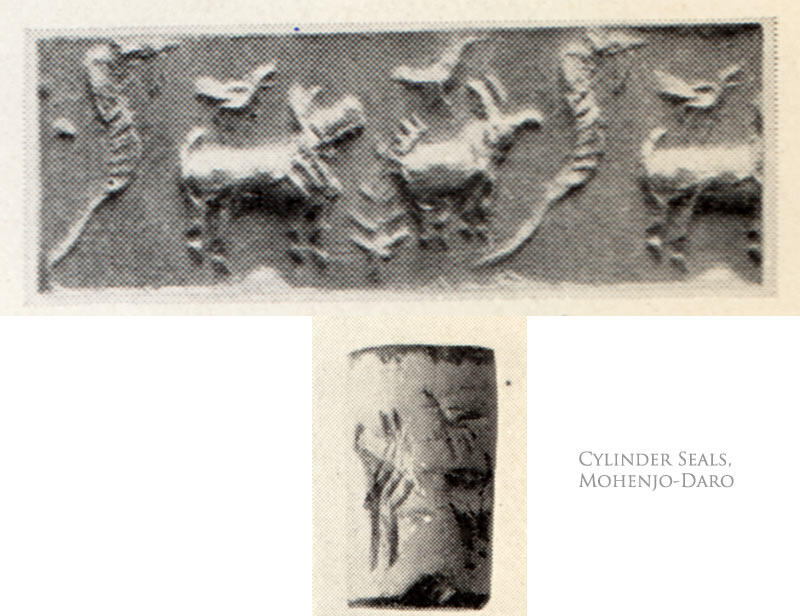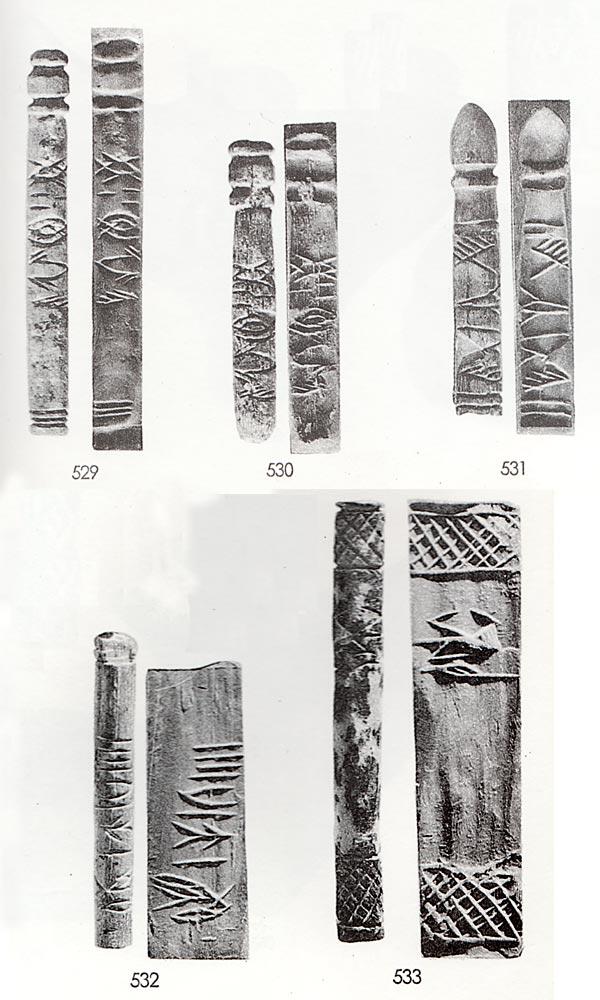May 4th, 2016
"The cylinder seals of Mesopotamia constitute her most original art," wrote the scholar Henri Frankfort, and much the same has been said about the very different square stamp seals used by the ancient Indus civilization. Cylinder seals are "small, barrel-shaped stone object[s] with a hole down the center, rolled on clay when soft to indicate ownership or to authenticate a document . . . used chiefly in Mesopotamia from the late 4th to the 1st millennium BCE." Many of the handful of cylinder seals found at ancient Indus sites or Mesopotamian ones with Indus themes are collected below.
1. Impression of a Harappan cylinder seal from Kalibangan (K-65). "Two warriors, distinguished by the hair worn in a divided bun at the back of the head, are spearing each other, while they are both being held by the hand by a goddess wearing a head-dress with a long pendant (comparable to the ones decorated with cowry shells and turquoise that are worn by the women of Ladakh and Chitral), bangles on the arms, and a skirt. Next to the combat scene (where space appears to have prevented the depiction of those details), her body merges with that of the tiger (later the Hindu goddess of war) and her head-dress is elaborated with animal horns and a tree branch," writes Asko Parpola in Deciphering the Indus Script, p. 253.
2. "The most reliable evidence of the date of the upper levels of Mohenjo-daro still continues to be Dr. Frankfort's seal. This seal [2] is cylindrical in form and of a totally different shape from the majority of the seals found in the Indus valley; but as three cylindrical specimens have been found at Mohenjo-daro, all of them, it should be noted, in the upper levels of that city, it is probably that they also were sometimes used by the inhabitants . The Tell Asmar seal [3] is, however, certainly of Indian workmanship. Not only are the animals upon it Indian, the elephant, rhinoceros, and gharial, or fish-eating crocodile, none of which ever appears on Sumerian or Akkadian seals, but the style of the carving is undoubtedly Indian." Ernest J. Mackay, The Indus Civilization, 1935, p. 193.
3. Imported Indian seal from Tell Asmar. "The Indus civilization used the signet, but knew the cylinder seal. Whether the five tall ivory cylinders [4] tentatively explained as seals in Sir John Marshall's work were used for that purpose remains uncertain. They have nothing in common with the seal cylinders of the Near East. In the upper layers of Mohenjo Daro, however, three cylinder seals were found [2,3]. The published specimen shows two animals with birds upon their backs [2], a snake and a small conventional tree. It is an inferior piece of work which displays none of the characteristics of the finely engraved stamp-seals which are so distinctive a feature of early Indian remains. Another cylinder of glazed steatite was discovered at Tell Asmar in Iraq, but here the peculiarities of design, as well as the subject, show such close resemblances to seals from the Indus valley that its Indian origin is certain [3]. The elephant, rhinoceros and crocodile (gharial), foreign to Babylonia, were obviously carved by an artist to whom they were familiar, as appears from the faithful rendering of the skin of the rhinoceros (closely resembling the plate-armour) and the sloping back and bulbous forehead of the elephant. Certain other peculiarities of style connect the seal as definitely with the Indus civilisation as if it actually bore the signs of the Indus script. Such is the convention by which the feet of the elephant are rendered and the network of lines, in other Indian seals mostly confined to the ears, but extending here over the whole of his head and trunk. The setting of the ears of the rhinoceros on two little stems is also a feature connecting this cylinder with the Indus valley seals." (H. Frankfort, Cylinder Seals, Macmillan and Co., 1939, p. 304-305.)
4. John Marshall wrote: "Seals of this group [cylinder seals, although Mackay above is not sure they are true cylinder seals]], if indeed they are seals, are very rarely found at Mohenjo-daro, only five specimen being obtained in all. They are all made of ivory and differ from the cylinder seals of other countries in being very long and thing; nor are they perforated for suspension on a cord. It is possible that these so-called seals are not true seals at all. They incised characters upon them might conceivably be identification marks for a game or something similar. On the other hand, they are certainly suitable for use a seals and in this account they are included in this chapter For the sake of clearness the actual seal is shown side by side with each impression.
No 529 (Pl. CXIV, HR 5515). Ivory. 2.7 inches long by 0.25 in. in diameter. Double groove at one end for attachment of cord. The other end is decorated with three parallel grooves. Level, 4 feet below surface. Central Courtyard (30), House LIII, Block 7, HR Area.
No 530 (Pl. CXIV, HR 4985). Ivory. 2.05 inches long by 0.25 in. in diameter. Double groove at one end for a cord; the other end is broken. Level 3 feet below surface. Central Courtyard (30), House LIII, Block 7, HR Area.
No 531 (Pl. CXIV, DK 2666). Ivory. Now 2.05 inches long by 0.3 in. in diameter. Its polish shows that it has been much used. About one-half of the seal is covered with an inscription, deeply and roughly incised and bordered by two deep cut lines. One end of the seal is shaped into a conical head with a deep groove possibly intended for a cord. The seal is not bored; nor is it perfectly round. Level, 4 feet below surface. Street between Blocks 1 and 2, Section B, DK Area.
No 532 (Pl. CXIV, VS 875). Ivory. Now 2 inches long by 0.3 in. in diameter. One end is broken and a small piece is missing. The seal tapers slightly towards its complete end. Five deeply incised characters occupy a space of about two-thirds of the circumference of the seal. Level, 12 feet below surface. Found in front of Room 70, House XXVII, VS Area.
No 533 (Pl. CXIV, VS 958). Ivory. 2.75 inches long by 0.3 in. in diameter. Decorated at 0-.5 in. from each end with a deeply incised cross-hatched border. Towards one end of the intervening space are two deeply incised characters This seal is not perfectly round. Level, 10 feet below surface of the ground. From Room 69, House XXVIII, VS Area. (John Marshall, Mohenjo-daro and the Indus Civilization, p. 371
5 and 6. These are not Indus seals, but appear in Frankfort as seals from Mesopotamia, and bear some resemblance to the Mackay seals above [2, 3] and point to some of the similarities between the contemporaneous Mesopotamian and Indus civilizations.












